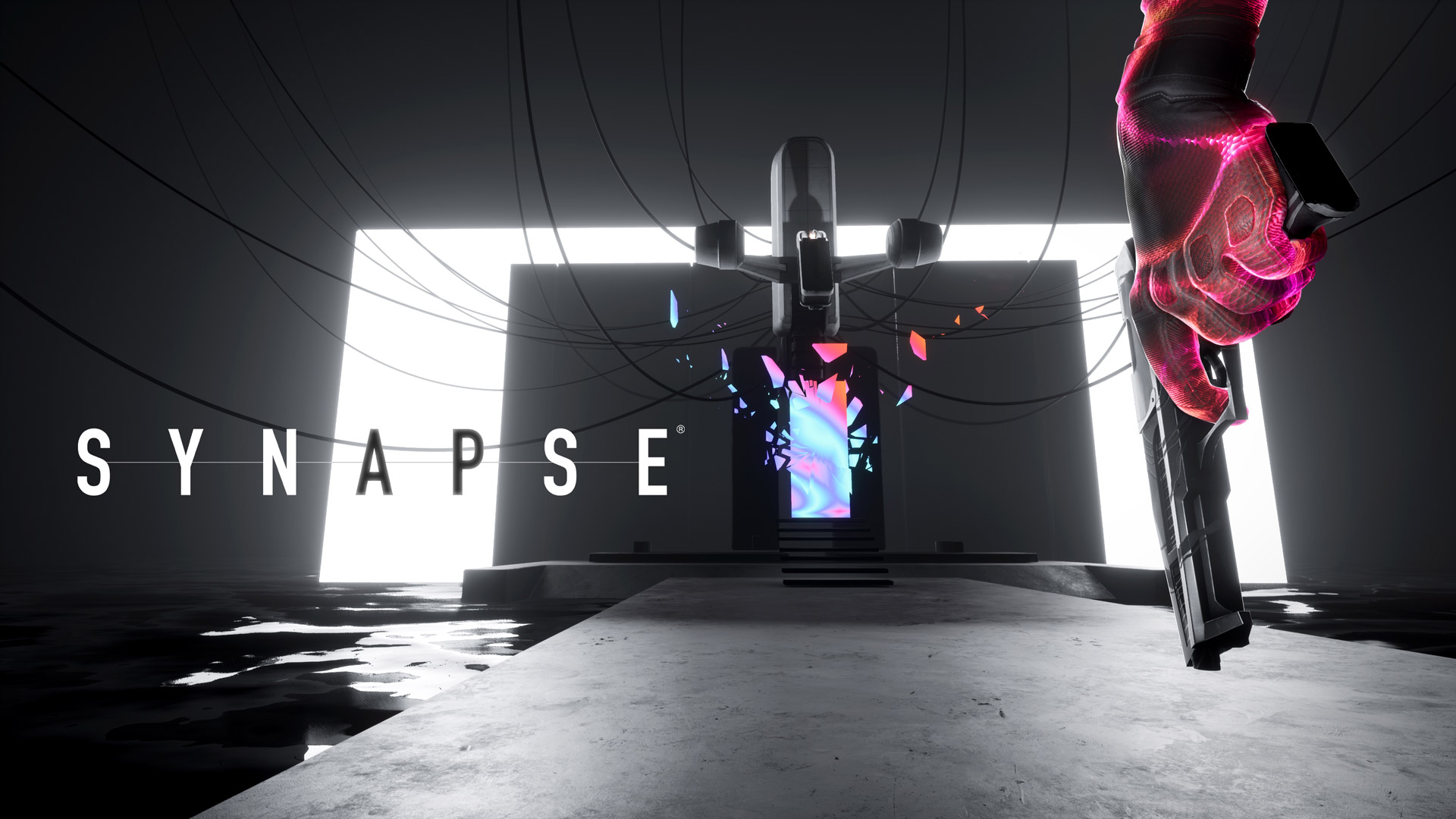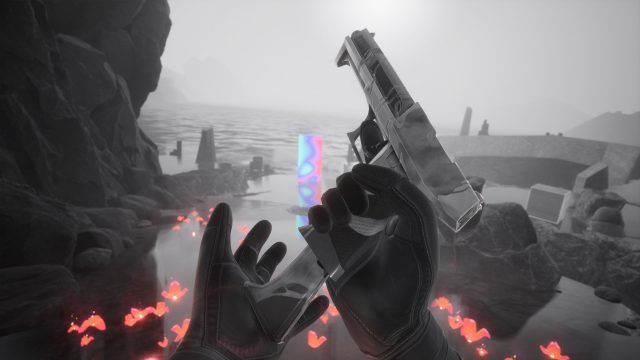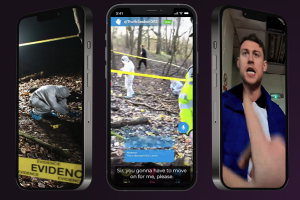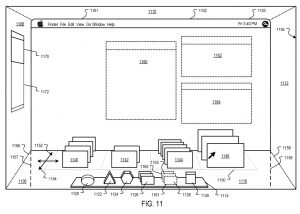
Synapse Review on PSVR 2 – A Power I’ve Been Waiting For
Synapse is the latest action game from veteran VR studio nDreams, built exclusively for PSVR 2. While you’ll do plenty of shooting, players are also equipped with a telekinetic superpower that feels great as a core mechanic. But does the rest of the game live up to it? Read on to find out.
Synapse Details:
Available On: PSVR 2 (exclusive)
Release Date: July 4th, 2023
Price: $35
Developer: nDreams
Gameplay
Editor’s Note: Gameplay clips may not appear with cookies disabled, click ‘View clip’ to see them in a separate window.
Synapse is a roguelite shooter where you’ll be blasting baddies with a weapon in one hand and controlling a telekinetic force power with the other. The game’s telekinesis ability is finely tuned, relying on PSVR 2’s eye-tracking to target whichever item you’re looking at. Look at a box and pull the trigger and suddenly you’re controlling its movements from afar. Look at an exploding barrel and pull the trigger and now you can toss it over to some enemies before pulling the trigger even harder to make it explode. Oh, and when you eventually get the ability to pick up enemies with your power, you’ll really enjoy launching them into the sky or send them crashing into the ground.
View clip
Over many years I’ve wondered why we haven’t seen a major VR game built around a ‘gravity gun’ like mechanic. It seems so natural to want to interact with virtual worlds using interesting physics mechanics rather than just shooting.
Well Synapse definitely proves out the mechanic with a strong core implementation that feels a little bit like magic thanks to the eye-tracking targeting which generally works well (just don’t forget to recalibrate your eye-tracking). It’s undeniably fun to look at an enemy, pick them up, and send them flying to a timely demise.
View clip
I also enjoyed the use of a two-stage trigger when it comes to manipulating explosive barrels—a light trigger pull lets you lift the barrel, while a full trigger pull makes it explode. It feels very intuitive while at the same time challenging you to think more carefully in the heat of battle about which object you’re controlling. It can feel effortless to see a barrel on the other side of the room, pick it up, then quickly hover it over to a group of enemies before crushing it to blow them away.
While I was hoping that there would be an increasing number of ways to interact with the environment using telekinesis, there’s little evolution on that front. You can control boxes, barrels, platforms, and (with later unlocks) enemies and grenades. But that’s about it. While the core mechanic feels great, it’s unfortunate that it doesn’t evolve into something more.
View clip
In your other hand you’ll start with a pistol which is about as standard as you’d expect, though nDreams adapted the great reloading system from Fracked to give Synapse an even quicker and easier reloading system that works great for the game’s combat pace.
When you’re out of ammo the mag will eject just a few inches out of the gun and then stay there. To reload all you have to do is push it back into the gun. It sounds a little silly, but makes sense in the context of the game’s mind-bending subject matter. And another nice detail (which I can’t recall if the game even explicitly teaches you) is that your hand doesn’t need to be the thing that pushes the mag back into your weapon to reload… you can shove your gun against a wall or a rock to slide it back in too—a clever way to allow for an improvised one-handed reload.
View clip
Reloading by pushing your mag against a wall works especially well considering the game’s hand-based cover system (also carried over from Fracked), which allows you to reach out to grab any cover and then use your hand to peek yourself in and out of said cover. It feels really natural and way more immersive than using the thumbstick to slide in and out of cover while crouched behind a wall.
As a roguelite there’s also unlocks to earn; some are temporary buffs that only last for your current run, while others are permanent and will make you better and stronger over time.
Everything I’ve said about the game so far is pretty positive, and warranted. But the game follows a strangely familiar pattern of flaws.
The thing about Synapse is that while the core mechanics (like telekinesis, reloading, and cover) work well, the rest of the game is a largely average wave shooter in the form of a roguelite. Quite unfortunately, many of the same core critiques of Synapse were equally true of nDreams’ last two big games: Fracked (2021) and Phantom: Covert Ops (2020).
It is a classic prognosis for the studio’s big action games at this point—not enough weapon, enemy, and encounter variety to really make the game sing.
For one, the game’s ‘levels’ feel completely homogenous. Combat isn’t meaningfully different from one to the next, which means every level feels essentially the same. Some destructible elements mix things up just a bit, but not enough to make levels feel dynamic and interesting.
View clip
And then there’s the mere four enemies: regular soldier dudes, kamikazes, hefty bois™, and one rather annoying flying enemy.
Some of the AI is actually pretty good. Soldier dudes will move around, use cover, flank you, and throw some suspiciously accurate grenades at your feet. Hefty bois will keep you pinned down behind cover, throw objects at you, and charge at you.

On the other hand, the exploding kamikaze enemies feel consistently more unfair than anything, considering they usually explode at your feet even after you killed them, thanks to momentum carrying their corpses right into you.
And then there’s the flying enemies which are much more of a nuisance than an interesting threat… and animate so poorly (making them difficult to hit) that I’m not sure if they’re bugged or not.
View clip
Luckily my hatred for them made it that much more satisfying when I realized I could use my telekinesis to drop them into searing hot lava for an instant death.
View clip
Minimal enemy variety is backed by a lack of encounter and scenario variety. Every level is beaten by killing all enemies on the map; they all seem to spawn fairly randomly and tend to come from all sides, making it feel like a wave shooter most of the time. Not only does the level’s objective never vary, but there’s a real lack of meaningful encounter design, making most fights feel the same.
That’s not to say that Synapse isn’t fun. I enjoyed my first full run through the game, which took about three hours to complete. But from then on out the game asks you to continue doing the same things against the same enemies with the same weapon and abilities—but now at a harder difficulty.
That’s usually how roguelites go, but there just isn’t enough variety in the gameplay or build options in Synapse to reach that engaging feeling of ‘just one more run’ after you’ve completed your first. Even the promise of unlocking more narrative through during subsequent runs isn’t enough considering the narrative is a paper-thin radio drama. nDreams says players can expect to take around 12 hours to complete three runs, each at increasing difficulty, which will reveal all of the narrative. But I have to say that I wasn’t compelled to complete all three. All-in, I probably spent about five hours with the game before feeling like I’d seen it all.
Immersion
View clip
Synapse has a really unique art style that I think they executed very well. The game runs well and generally sounds good too.
There’s no doubt the telekinesis is a more interesting and immersive way to interact with the game than shooting enemies at a distance. Being able to grip enemies with an invisible force, then toss them toward you while firing a flurry of bullets at them mid-air gives a strong feeling of direct control over the game’s virtual world, which helps anchor you to it.
View clip
Similarly, using your hand to pull yourself in and out of cover, then slapping your mag against a rock to load it into your gun, feel very ‘hands-on’.

Aside from these elements, most of the game is fairly run-and-gun and there’s almost no other up-close interactions (which are the kind that tend to drive high levels of immersion). While the setting is neat (battling inside of someone’s brain, à la Inception), the story had zero intrigue, and served only as a rough premise for the action that unfolds in the game.
Comfort
Synapse is a run-and-gun game that doesn’t offer teleport. Aside from that, the essential comfort options are available, though I’m irked by the game’s implementation of snap turning, which is actually just a quick turn rather than a true snap turn (which tends to be more comfortable); Fracked had the very same issue.
Without teleport and with the expected pace of combat, Fracked might be a challenge for anyone that’s very sensitive to motion in VR, but otherwise feels largely average for comfort in a VR shooter.
One miscellaneous item worth noting here is that the game’s pistol tends to consistently shoot up and to one side, seemingly due to a lack of filtering on the weapon’s movement and the particular way the PSVR 2 controller tends to move in your hand when pulling the trigger in its ‘stiff’ state. This makes the pistol much less accurate than it seems it’s supposed to be.
Synapse’ Comfort Settings – June 28th, 2023 |
|
Turning |
|
| Artificial turning | ✔ |
| Snap-turn | ✖ |
| Quick-turn | ✔ |
| Smooth-turn | ✔ |
Movement |
|
| Artificial movement | ✔ |
| Teleport-move | ✖ |
| Dash-move | ✖ |
| Smooth-move | ✔ |
| Blinders | ✔ |
| Head-based | ✔ |
| Controller-based | ✔ |
| Swappable movement hand | ✖ |
Posture |
|
| Standing mode | ✔ |
| Seated mode | ✔ |
| Artificial crouch | ✔ |
| Real crouch | ✔ |
Accessibility |
|
| Subtitles | ✔ |
| Languages | English, French, Italian, German, Spanish, Korean, Japanese, Brazilian |
| Dialogue audio | ✔ |
| Languages | English |
| Adjustable difficulty | ✔ |
| Two hands required | ✔ |
| Real crouch required | ✖ |
| Hearing required | ✖ |
| Adjustable player height | ✔ |


